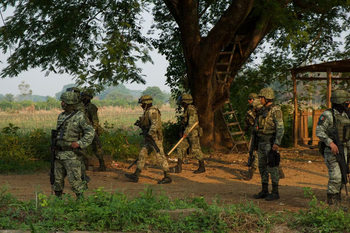Thousands of people have been displaced and others killed in Mexico’s southern state of Chiapas, as the Sinaloa Cartel and the CJNG clash over drug trafficking and migrant smuggling routes originating in neighboring Guatemala.
Over 3,000 residents of Frontera Comalapa, a municipality just north of the Guatemalan border, have been forced to flee their homes and at least 60 people have been killed in the last two weeks, according to news site Animal Político, which cited the Chiapas’ coordinator of the National Guard.
These displacements and killings are allegedly the result of a rapid increase in violence between factions associated with the Sinaloa Cartel and the Jalisco Cartel New Generation (Cartel Jalisco Nueva Generación – CJNG), with video footage shared on social media of “narco-tanks” — heavily-armored cartel vehicles — patrolling Frontera Comalapa.
Over 1,500 army and police personnel were sent to secure the area on May 29 amid a wave of executions, forced recruitment, and roadblocks, according to a report by the Chiapas-based Fray Bartolomé de las Casas Human Rights Center (Frayba).
The conflict in Frontera Comalapa has been brewing for at least two years as Mexico’s foremost criminal groups jostle for control of crucial drug trafficking and human smuggling routes.
“In this part of Mexico alongside Guatemala, especially the central southern part of Chiapas … criminal activities are transnational, especially drug trafficking, arms trafficking, and human smuggling,” Javier Oliva Posada, a professor of political science at the National Autonomous University of Mexico (Universidad Nacional Autónoma de México – UNAM), told InSight Crime.
The violence in Chiapas has come amid increasing revelations about how Mexican criminal groups are expanding their operations in Guatemala.
A Guatemalan colonel recently revealed how corrupt officers had helped the CJNG to traffic cocaine through the country as far back as 2017. And in April, the United States indicted Ana Gabriela Rubio Zea, who allegedly ran an international network of brokers seeking to buy chemical precursors used to make fentanyl on behalf of the Chapitos, the sons of Joaquín Guzmán Loera, alias “El Chapo.”
InSight Crime Analysis
The suffering in Chiapas mirrors the plight of Mexico’s northern states on the US border and is a result of its convenient location along a major transnational trafficking and smuggling route.
As tens of thousands of Central American migrants continue to cross the Guatemala-Mexico border yearly, many stop first in Frontera Comalapa. From there, they are taken through mountain paths to La Angostura, a man-made reservoir, and continue north by boat or by road. In November 2022, 368 migrants were detained after following this exact route.
Drugs and weapons are moved around an 80-kilometer stretch of border territory, with Frontera Comalapa at its center, according to the Associated Press. Documents leaked from Mexico’s Defense Ministry (SEDENA) last year also identified Frontera Comalapa as being among a network of border towns used as cocaine transshipment hubs by the Sinaloa Cartel.
SEE ALSO: Guatemala Ex-Colonel Says Military Helped CJNG Run Drugs
The latest outbreak of violence has happened as the CJNG seeks to contest this space. Animal Politico suggested that Frontera Comalapa was split in two, with the CJNG controlling areas next to the border and the Sinaloa Cartel operating in its mountainous northern areas.
“While the border is very long and porous, they are fighting anyway for this area. The routes [leaving Frontera Comalapa] diversify the methods of travel for illegal activities,” Oliva Posada told InSight Crime.
This violence is also the extension of a broader trend that has seen the CJNG contesting the Sinaloa Cartel’s strong presence in Guatemala.
An InSight Crime investigation in May 2022 helped reveal the extent to which the CJNG has been smuggling cocaine, heroin, and methamphetamine through Guatemala. It has struck deals with Guatemalan drug rings, as well as corrupting army officials, to transport shipments by land and sea to the Mexican border. This has included forming an alliance with the Huistas, one of Guatemala’s best-known drug gangs, who used to work mostly with the Sinaloa Cartel.

